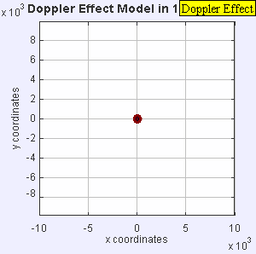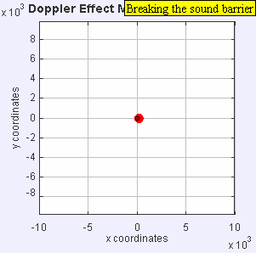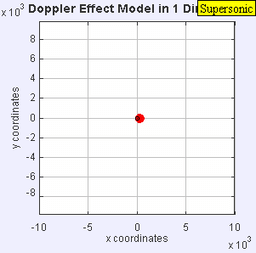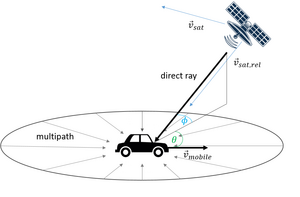Doppler effect

Doppler effect

An animation illustrating how the Doppler effect causes a car engine or siren to sound higher in pitch when it is approaching than when it is receding. The pink circles represent sound waves.
A common example of Doppler shift is the change of pitch heard when a vehicle sounding a horn approaches and recedes from an observer. Compared to the emitted frequency, the received frequency is higher during the approach, identical at the instant of passing by, and lower during the recession.[8]
The reason for the Doppler effect is that when the source of the waves is moving towards the observer, each successive wave crest is emitted from a position closer to the observer than the crest of the previous wave.[8][9] Therefore, each wave takes slightly less time to reach the observer than the previous wave. Hence, the time between the arrivals of successive wave crests at the observer is reduced, causing an increase in the frequency. While they are traveling, the distance between successive wave fronts is reduced, so the waves "bunch together". Conversely, if the source of waves is moving away from the observer, each wave is emitted from a position farther from the observer than the previous wave, so the arrival time between successive waves is increased, reducing the frequency. The distance between successive wave fronts is then increased, so the waves "spread out".
For waves that propagate in a medium, such as sound waves, the velocity of the observer and of the source are relative to the medium in which the waves are transmitted.[7] The total Doppler effect may therefore result from motion of the source, motion of the observer, or motion of the medium. Each of these effects is analyzed separately. For waves which do not require a medium, such as light or gravity in general relativity, only the relative difference in velocity between the observer and the source needs to be considered.
History
Doppler first proposed this effect in 1842 in his treatise "Über das farbige Licht der Doppelsterne und einiger anderer Gestirne des Himmels" (On the coloured light of the binary stars and some other stars of the heavens).[10] The hypothesis was tested for sound waves by Buys Ballot in 1845.[1] He confirmed that the sound's pitch was higher than the emitted frequency when the sound source approached him, and lower than the emitted frequency when the sound source receded from him. Hippolyte Fizeau discovered independently the same phenomenon on electromagnetic waves in 1848 (in France, the effect is sometimes called "effet Doppler-Fizeau" but that name was not adopted by the rest of the world as Fizeau's discovery was six years after Doppler's proposal).[2][11] In Britain, John Scott Russell made an experimental study of the Doppler effect (1848).[3]
General
 and emitted frequency
and emitted frequency is given by:[12]
is given by:[12]is the velocity of waves in the medium;
is the velocity of the receiver relative to the medium; positive if the receiver is moving towards the source (and negative in the other direction);
is the velocity of the source relative to the medium; positive if the source is moving away from the receiver (and negative in the other direction).
The frequency is decreased if either is moving away from the other.
Equivalent formula, easier to remember:
is the wave's velocity relative to the receiver;
is the wave's velocity relative to the source;
is the wavelength.
The above formula assumes that the source is either directly approaching or receding from the observer. If the source approaches the observer at an angle (but still with a constant velocity), the observed frequency that is first heard is higher than the object's emitted frequency. Thereafter, there is a monotonic decrease in the observed frequency as it gets closer to the observer, through equality when it is coming from a direction perpendicular to the relative motion (and was emitted at the point of closest approach; but when the wave is received, the source and observer will no longer be at their closest), and a continued monotonic decrease as it recedes from the observer. When the observer is very close to the path of the object, the transition from high to low frequency is very abrupt. When the observer is far from the path of the object, the transition from high to low frequency is gradual.
 and
and are small compared to the speed of the wave, the relationship between observed frequency
are small compared to the speed of the wave, the relationship between observed frequency and emitted frequency
and emitted frequency is approximately[12]
is approximately[12]| Observed frequency | Change in frequency |
|---|---|
 |  |
- where
is the opposite of the velocity of the receiver relative to the source: it is positive when the source and the receiver are moving towards each other.



 we can substitute the geometric expansion:
we can substitute the geometric expansion:
Analysis
To understand what happens, consider the following analogy. Someone throws one ball every second at a man. Assume that balls travel with constant velocity. If the thrower is stationary, the man will receive one ball every second. However, if the thrower is moving towards the man, he will receive balls more frequently because the balls will be less spaced out. The inverse is true if the thrower is moving away from the man. So it is actually the wavelength which is affected; as a consequence, the received frequency is also affected. It may also be said that the velocity of the wave remains constant whereas wavelength changes; hence frequency also changes.
 (in this case, the wavelength is changed, the transmission velocity of the wave keeps constant
(in this case, the wavelength is changed, the transmission velocity of the wave keeps constant note that the transmission velocity of the wave does not depend on the velocity of the source), then the observer detects waves with a frequency
note that the transmission velocity of the wave does not depend on the velocity of the source), then the observer detects waves with a frequency given by
given by
 and hence the transmission velocity of the wave [with respect to the observer]
and hence the transmission velocity of the wave [with respect to the observer] is changed) yields the observed frequency:
is changed) yields the observed frequency:
These can be generalized into the equation that was presented in the previous section.

An interesting effect was predicted by Lord Rayleigh in his classic book on sound: if the source is moving toward the observer at twice the speed of sound, a musical piece emitted by that source would be heard in correct time and tune, but backwards.[13] The Doppler effect with sound is only clearly heard with objects moving at high speed, as change in frequency of musical tone involves a speed of around 40 meters per second, and smaller changes in frequency can easily be confused by changes in the amplitude of the sounds from moving emitters. Neil A Downie has demonstrated [14] how the Doppler effect can be made much more easily audible by using an ultrasonic (e.g. 40 kHz) emitter on the moving object. The observer then uses a heterodyne frequency converter, as used in many bat detectors, to listen to a band around 40 kHz. In this case, with the bat detector tuned to give frequency for the stationary emitter of 2000 Hz, the observer will perceive a frequency shift of a whole tone, 240 Hz, if the emitter travels at 2 meters per second.
Application
Robotics
Dynamic real-time path planning in robotics to aid the movement of robots in a sophisticated environment with moving obstacles often take help of Doppler effect[15]. Such applications are specially used for competitive robotics where the environment is constantly changing, such as robosoccer.
Sirens

Sirens on passing emergency vehicles.
A siren on a passing emergency vehicle will start out higher than its stationary pitch, slide down as it passes, and continue lower than its stationary pitch as it recedes from the observer. Astronomer John Dobson explained the effect thus:
The reason the siren slides is because it doesn't hit you.
In other words, if the siren approached the observer directly, the pitch would remain constant, at a higher than stationary pitch, until the vehicle hit him, and then immediately jump to a new lower pitch. Because the vehicle passes by the observer, the radial velocity does not remain constant, but instead varies as a function of the angle between his line of sight and the siren's velocity:

 is the angle between the object's forward velocity and the line of sight from the object to the observer.
is the angle between the object's forward velocity and the line of sight from the object to the observer.Astronomy

Redshift of spectral lines in the optical spectrum of a supercluster of distant galaxies (right), as compared to that of the Sun (left)
The Doppler effect for electromagnetic waves such as light is of great use in astronomy and results in either a so-called redshift or blueshift. It has been used to measure the speed at which stars and galaxies are approaching or receding from us; that is, their radial velocities. This may be used to detect if an apparently single star is, in reality, a close binary, to measure the rotational speed of stars and galaxies, or to detect exoplanets. This redshift and blueshift happens on a very small scale. If an object was moving toward earth, there would not be a noticeable difference in visible light, to the unaided eye.[16]
Note that redshift is also used to measure the expansion of space, but that this is not truly a Doppler effect.[17] Rather, redshifting due to the expansion of space is known as cosmological redshift, which can be derived purely from the Robertson-Walker metric under the formalism of General Relativity. Having said this, it also happens that there are detectable Doppler effects on cosmological scales, which, if incorrectly interpreted as cosmological in origin, lead to the observation of redshift-space distortions.[18]
The use of the Doppler effect for light in astronomy depends on our knowledge that the spectra of stars are not homogeneous. They exhibit absorption lines at well defined frequencies that are correlated with the energies required to excite electrons in various elements from one level to another. The Doppler effect is recognizable in the fact that the absorption lines are not always at the frequencies that are obtained from the spectrum of a stationary light source. Since blue light has a higher frequency than red light, the spectral lines of an approaching astronomical light source exhibit a blueshift and those of a receding astronomical light source exhibit a redshift.
Among the nearby stars, the largest radial velocities with respect to the Sun are +308 km/s (BD-15°4041, also known as LHS 52, 81.7 light-years away) and −260 km/s (Woolley 9722, also known as Wolf 1106 and LHS 64, 78.2 light-years away). Positive radial velocity means the star is receding from the Sun, negative that it is approaching.
Radar
The Doppler effect is used in some types of radar, to measure the velocity of detected objects. A radar beam is fired at a moving target — e.g. a motor car, as police use radar to detect speeding motorists — as it approaches or recedes from the radar source. Each successive radar wave has to travel farther to reach the car, before being reflected and re-detected near the source. As each wave has to move farther, the gap between each wave increases, increasing the wavelength. In some situations, the radar beam is fired at the moving car as it approaches, in which case each successive wave travels a lesser distance, decreasing the wavelength. In either situation, calculations from the Doppler effect accurately determine the car's velocity. Moreover, the proximity fuze, developed during World War II, relies upon Doppler radar to detonate explosives at the correct time, height, distance, etc.
 is twice that from the same target emitting a wave:
is twice that from the same target emitting a wave: .[19]
.[19]Medical
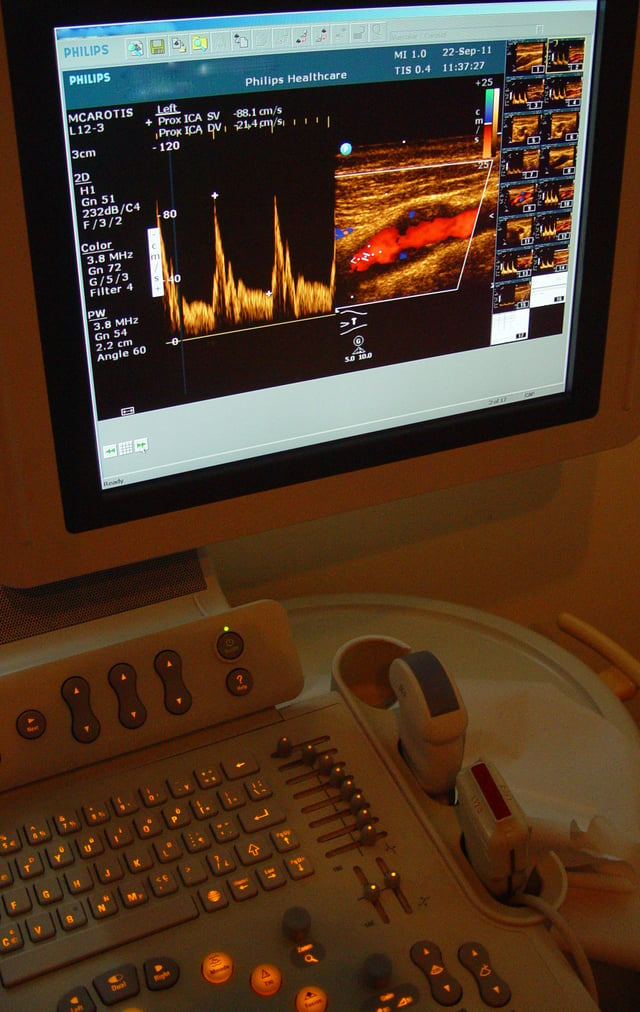
Colour flow ultrasonography (Doppler) of a carotid artery – scanner and screen
An echocardiogram can, within certain limits, produce an accurate assessment of the direction of blood flow and the velocity of blood and cardiac tissue at any arbitrary point using the Doppler effect. One of the limitations is that the ultrasound beam should be as parallel to the blood flow as possible. Velocity measurements allow assessment of cardiac valve areas and function, abnormal communications between the left and right side of the heart, leaking of blood through the valves (valvular regurgitation), and calculation of the cardiac output. Contrast-enhanced ultrasound using gas-filled microbubble contrast media can be used to improve velocity or other flow-related medical measurements.[20][21]
Although "Doppler" has become synonymous with "velocity measurement" in medical imaging, in many cases it is not the frequency shift (Doppler shift) of the received signal that is measured, but the phase shift (when the received signal arrives).[4]
Flow measurement
Instruments such as the laser Doppler velocimeter (LDV), and acoustic Doppler velocimeter (ADV) have been developed to measure velocities in a fluid flow. The LDV emits a light beam and the ADV emits an ultrasonic acoustic burst, and measure the Doppler shift in wavelengths of reflections from particles moving with the flow. The actual flow is computed as a function of the water velocity and phase. This technique allows non-intrusive flow measurements, at high precision and high frequency.
Velocity profile measurement
Developed originally for velocity measurements in medical applications (blood flow), Ultrasonic Doppler Velocimetry (UDV) can measure in real time complete velocity profile in almost any liquids containing particles in suspension such as dust, gas bubbles, emulsions. Flows can be pulsating, oscillating, laminar or turbulent, stationary or transient. This technique is fully non-invasive.
Satellite communication
Fast moving satellites can have a Doppler shift of dozens of kilohertz relative to a ground station. The speed, thus magnitude of Doppler effect, changes due to earth curvature. Dynamic Doppler compensation, where the frequency of a signal is changed progressively during transmission, is used so the satellite receives a constant frequency signal.[24]
Doppler shift of the direct path can be estimated by the following formula:[25]

 is the velocity of the mobile station,
is the velocity of the mobile station, is the wavelength of the carrier,
is the wavelength of the carrier, is the elevation angle of the satellite and
is the elevation angle of the satellite and is the driving direction with respect to the satellite.
is the driving direction with respect to the satellite.The additional Doppler shift due to the satellite moving can be described as:

 is the relative speed of the satellite.
is the relative speed of the satellite.Audio
The Leslie speaker, most commonly associated with and predominantly used with the famous Hammond organ, takes advantage of the Doppler effect by using an electric motor to rotate an acoustic horn around a loudspeaker, sending its sound in a circle. This results at the listener's ear in rapidly fluctuating frequencies of a keyboard note.
Vibration measurement
A laser Doppler vibrometer (LDV) is a non-contact instrument for measuring vibration. The laser beam from the LDV is directed at the surface of interest, and the vibration amplitude and frequency are extracted from the Doppler shift of the laser beam frequency due to the motion of the surface.
Developmental biology
During the segmentation of vertebrate embryos, waves of gene expression sweep across the presomitic mesoderm, the tissue from which the precursors of the vertebrae (somites) are formed. A new somite is formed upon arrival of a wave at the anterior end of the presomitic mesoderm. In zebrafish, it has been shown that the shortening of the presomitic mesoderm during segmentation leads to a Doppler effect as the anterior end of the tissue moves into the waves. This Doppler effect contributes to the period of segmentation.[5]
Inverse Doppler effect
Since 1968 scientists such as Victor Veselago have speculated about the possibility of an inverse Doppler effect. The size of the Doppler shift depends on the refractive index of the medium a wave is traveling through. But some materials are capable of negative refraction, which should lead to a Doppler shift that works in a direction opposite that of a conventional Doppler shift.[26] First experiment that detected this effect was conducted by Nigel Seddon and Trevor Bearpark in Bristol, United Kingdom in 2003.[6] Later inverse Doppler effect was observed in some inhomogeneous materials and predicted inside Vavilov–Cherenkov cone.[27]
See also
Differential Doppler effect
Doppler cooling
Dopplergraph
Fading
Fizeau experiment
Photoacoustic Doppler effect
Rayleigh fading
Redshift
Relativistic Doppler effect
